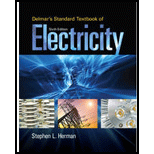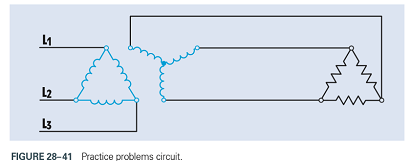

The missing values in the given table.
Answer to Problem 7PP
| EP = 208 V | ES1 = 320 V | ES2 = 120 V | ES3 = 24 V |
| IP = 11.96 A | IS1 = 0.0267 A | IS2 = 20 A | IS3 = 3 A |
| NP = 800 turns | NS1 = 1232 turns | NS = 462 turns | NS = 92 turns |
| Ratio 1 =1:1.54 | Ratio 2 =1.73:1 | Ratio 3 = 8.67:1 | |
| R1 =12 kΩ | R2 = 6 Ω | R3 = 8 Ω |
Explanation of Solution
The transformer in the fig 27-17 contains one primary winding and three secondary windings.
The primary is connected to 480 V AC and contains 800 turns of wire.
One secondary has an output voltage of 320 volts and a load resistance of 12 kΩ.
Second secondary has an output voltage of 120 volts and a load resistance of 6 Ω.
Third secondary has an output voltage of 24 volts and a load impedance of 8 Ω.
The turns ratio of the first secondary can be found by dividing the smaller voltage into the larger:
The turns ratio of the first secondary is re written as,
The current flow in the first secondary can be calculated using Ohm’s law:
The amount of primary current needed to supply this secondary winding can be found using the turns ratio. As this primary has less voltage, it requires more current:
The number of turns of wire in the first secondary winding is found using the turns ratio. Because this secondary has a higher voltage than the primary, it must have more turns of wire:
The turns ratio of the second secondary winding is found by dividing the higher voltage by the lower:
The turns ratio of the second secondary is re written as,
The amount of current flow in this secondary can be determined using Ohm’s law:
The amount of primary current needed to supply this secondary winding can be found using the turns ratio. As this primary has more voltage, it requires less current:
Because the voltage of this secondary is lesser than the primary, it has less turns of wire than the primary. The number of turns of this secondary is found using the turns ratio:
The turns ratio of the third secondary winding is calculated in the same way as the other two. The larger voltage is divided by the smaller:
The turns ratio of the third secondary is re written as,
The secondary current is found using Ohm’s law:
The amount of primary current needed to supply this secondary winding can be found using the turns ratio. As this primary has more voltage, it requires less current:
Because the voltage of this secondary is lesser than the primary, it has less turns of wire than the primary. The number of turns of this third secondary is found using the turns ratio:
The primary must supply current to each of the three secondary windings. Therefore, the total amount of primary current is the sum of the currents required to supply each secondary:
Want to see more full solutions like this?
Chapter 28 Solutions
Mindtap Electrical, 4 Terms (24 Months) Printed Access Card For Herman's Delmar's Standard Textbook Of Electricity, 6th (mindtap Course List)
- Given the complex numbers A1=630 and A2=4+j5, (a) convert A1 to rectangular form: (b) convert A2 to polar and exponential form: (c) calculate A3=(A1+A2), giving your answer in polar form: (d) calculate A4=A1A2, giving your answer in rectangular form: (e) calculate A5=A1/(A2*) giving your answer in exponential form.arrow_forward三 T AaBbCcDc AaBbCcDc AABBC T Normal 1 No Spac. Heading Paragraph Styles In the circuit pictured the current through R1 is 11 = 6A in the direction shown. a) Determine the current 14. Describe choice of node or loop (including direction of travel). b) Determine the current 13. Describe choice of node or loop (including direction of travel). c) Determine the Determine the potential difference Vgd = Vg Vd between points g and d.arrow_forwardR1 = 1 kohms R2 = 1.4 kohms R3 = 6.8 kohms E = 8VD1: Si, rB = 2 ohms, rR = 215 kohms D2: Si, rB = 7 ohms, rR = 590 kohmsApplying second approximations, determine: a) Current through D1 b) Voltage across D_2 c) Voltage across R_3arrow_forward
- Bonomo Bulunmam G s/94048/quizzes/119102/take j3N 1179 20/150 } 19912 1172 20- 907 19912 20230° 1952 a)Ls yuk akımını bnlunuz (100 puan) b) Vac hal gerilimini veriniz(0 puan) c) Yukler üzerindekitoplamkompleks gücu hesaplavnez (10 puan) Kısa Sinavı G ASUS 14 f5 f6 f7 f8 f10arrow_forwardSTEP2 : Indicate the polarities within each Loap for eaclh resistor as determined by the assumed direction of laap curreut 6or that Icop. R, R23 14 I, I2 GV E2 2Varrow_forwardR1 = 1 kohms R2 = 1.4 kohms R3 = 6.8 kohms E = 8VD1: Si, rB = 2 ohms, rR = 215 kohms D2: Si, rB = 7 ohms, rR = 590 kohmsApplying first approximations, determine: a) Current through D1 b) Voltage across D_2 c) Voltage across R_3arrow_forward
- ETY Section1 Lecture (20201_110913130_AAUP - JENIN) / äwlj / Saill a 13 Magnetic sensor requires no supply True .a O 0.50 False .b O Jarrow_forwardcmid3D11648 This course Use current division to find the current i 120 flowing through the 120 resistor. 28 N 21 0 200 mA( ↑) 12 Ng 20 Ωξ 18 ΩΣ Select one: O a. 100 mA Ob. None of them Oc. 10 mA O d. 80 mA O e. 110 mA tion 7 When the given Delta circuit is converted to Wye circuit, the resistance values in the Wye circuit are: yetarrow_forwarda cylindrico| coordinote systen a suire carrying um long straight in the pasitive e direction ond - 2m L¢s2M a current 10 A 잉 r=8 cm, =14 is locoted at ) if B =Ĉ, .ucosp F.o.ucosp LT), what is the mognetia force octing on the wire? b) Haw much work is required to rotate the wirence Ź exis in the negartive $ dirzetion about the Cwhile mointaining r= Sem) ? a noxinom cAt what ogle $ is the fonce CamScanner ile tarandıarrow_forward
- A. Given the per unit equivalent circuit below, solve for V2 in per unit. I P₁=0.8 p.u. PF=0.9 lag ₁ V₁=1.0 p.u. 0.03+10.04 0.045+10.06 Answer: V2=0.9833 angle 0.2217 degrees P₁=1.2 p.u. PF=0.95 lag ~V₂ haun halow and show all paramarrow_forwardIed - 110 A N - 2700 turns per pole NSE - 14 turns per pole Prd - 30 hp V, = 240 V ned - 1800 r/min R -0.19 Q R = 0.02 N R, - 75 Q R = 100 to 400 2 Magnetization curve 300 280 260 Speed - 1800 r/in 240 220 > 200 180 160 140 120 100 80 60 40 20 0 0.1 02 0.3 0.4 0.5 0.6 0.7 0.8 0.9 1 1.1 12 1.3 1.4 1.5 1.6 1.7 1.8 1.9 2 Shunt field curent, A The motor is connected in shunt. If Radj can be adjusted from 100 to 400 W, what are the maximum and minimum no-load speeds possible with this motor? NOTE: Magnetization curve is given for 1800 rpm. (a) Maximum speed in rpm (b) Minimum speed in rpm Internal generated voltage E, Varrow_forwardConsidey i- 2.2A the ciocuit and that K= 3A1Jare Suppose 32v 1A 1752 1752 Qv seties of Soudece transformations ciycuit. Use a find io. the to in Sigmifeant units.. to Expiess Jous and ans we d include. three fques the appropriate 'arrow_forward
 Power System Analysis and Design (MindTap Course ...Electrical EngineeringISBN:9781305632134Author:J. Duncan Glover, Thomas Overbye, Mulukutla S. SarmaPublisher:Cengage Learning
Power System Analysis and Design (MindTap Course ...Electrical EngineeringISBN:9781305632134Author:J. Duncan Glover, Thomas Overbye, Mulukutla S. SarmaPublisher:Cengage Learning

